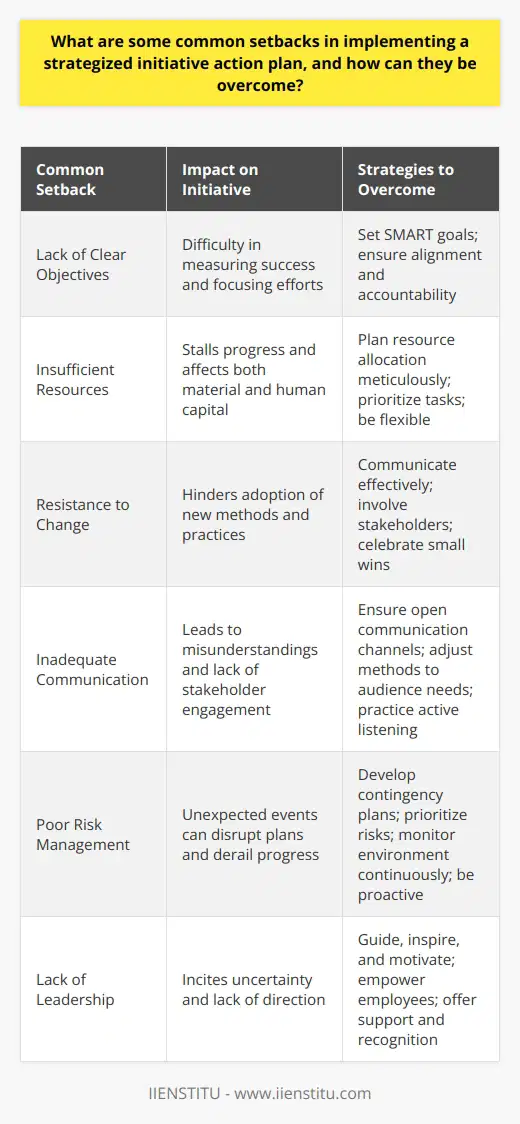
In today's fast-paced world, the ability to navigate challenges and progress towards goals is more critical than ever. Knowing where one is headed and mapping out the steps to get there is the essence of an effective strategy. In such a scenario, an action plan becomes an invaluable navigational tool, directing one's course of action across various spheres of life. This comprehensive guide aims to delve into the world of strategized initiatives, providing a blueprint for those intent on turning objectives into achievements. From the intricacies of planning to the nuances of execution, we will leave no stone unturned, ensuring that the content doesn't just educate but also enables.
Underpinning the discourse is an adherence to academic rigor and a clear, descriptive writing style, intended to convey complex ideas in a manner that is both accessible and authoritative. By weaving in authentic anecdotes and expert analyses, this article not only pledges to satisfy the curiosity of the reader but also keens to support the enrichment of their problem-solving prowess, be it through a problem solving skills course or a spontaneous spark of insight.
The Concept of an Action Plan
Defining an Action Plan
An action plan is a detailed proposal for achieving one's goals. It is a systematic and organized sequence of steps that outlines what needs to be done, by whom, and in what timeframe. This document or strategy acts as a roadmap, offering clear directions and checkpoints along the path to accomplishment. Crafting such a plan necessitates a blend of foresight, detail orientation, and an anticipatory approach, allowing one to foresee potential pitfalls and plot a course around them.
Significance of an Action Plan in Personal and Professional Settings
In both personal and professional domains, having an action plan is akin to possessing a compass on an intricate journey—it offers guidance when one risks becoming lost amid the distractions of daily life. In the workplace, action plans are instrumental in project management, ensuring that teams keep focus on objectives and collaborate effectively. On a personal level, they help individuals maintain motivation and structure as they work towards self-improvement, be it fitness goals, educational endeavors, or career aspirations.
Examples of Situations Where Action Plans Can Be Utilized
Imagine an entrepreneur starting a new business, a student aiming to improve their academic performance, or a health enthusiast working toward a marathon. For the entrepreneur, an action plan could encompass market research, funding, production, and marketing strategies. A student might create a study schedule, set benchmarks for understanding material, and arrange tutor sessions. The health enthusiast may plan training intensities, rest days, and dietary changes. These examples spotlight the adaptability and utility of action plans across diverse contexts.
Step-by-step Components of an Action Plan
Identification of Goals
The nucleus of an action plan is the identification of clear, specific, and achievable goals. This foundational step involves a deep introspection of what one truly desires to achieve and an assessment of the feasibility of these ambitions. A well-defined goal not only provides a focal point but also triggers the motivation necessary to initiate action.
Breakdown of Goals into Actionable Steps
After pinpointing the goals, the subsequent phase is the disintegration of these broad objectives into smaller, more manageable tasks. By doing so, an insurmountable goal suddenly appears conquerable. Each step is a milestone, and with every milestone reached, the journey towards the ultimate goal becomes less daunting.
Determination of Timelines
Crucial to an action plan is the establishment of deadlines. Timelines convey a sense of urgency and progress, helping to maintain momentum. They serve as alarms that sound at regular intervals, reminding us that the clock ticks and the window of opportunity doesn't remain open indefinitely.
Assigning Responsibility
In group settings, delegating responsibilities ensures that everyone involved knows their role and contributes to the group's collective effort. Individual accountability leads to a higher level of commitment and a lower likelihood of task negligence.
Monitoring Progress and Adjustment
No plan is foolproof, and the ability to adapt is a hallmark of an effective action plan. Regular evaluation of progress affords the opportunity to make adjustments, ensuring that the plan remains relevant and responsive to any unforeseen changes.
Review of Examples Demonstrating Each Step of the Action Plan Process
An example could be a departmental team in a corporate setting endeavoring to launch a new product. Their action plan might begin with market analysis (goal identification), followed by design, production, testing, and marketing steps (breakdown into steps), with each phase having its own deadline (timelines). Separate departments would take responsibility for their areas of expertise (assigning responsibility), and weekly meetings could be held to review progress (monitoring progress), making adjustments based on feedback and test results (adjustment).
The Role of an Action Plan in Achieving Success
Discussion on How an Action Plan Serves as a Tool for Accomplishment
An action plan functions not only as a strategic guide but also as a psychological stimulant. It breaks down complex endeavors into practical tasks, enabling one to perceive the roadmap to success with crisp clarity. The very act of documenting steps and strategies generates commitment and solidifies intent.
Analysis of How an Action Plan Can Reduce Stress and Increase Productivity
Having a reliable blueprint reduces ambiguity and the stress arising from it. When the mind is relieved of the strain of remembering and organizing tasks, it is freed up to focus on execution. Productivity naturally climbs due to the efficiency that arises from an environment stripped of uncertainty.
Discussion on How Action Plans Foster Accountability and Self-discipline
An effective action plan includes checks and balances that ensure that each milestone is not just met but is met well. It promotes a culture of accountability wherein individuals hold themselves to the standards they have pre-set, thereby enhancing self-discipline.
Examples of Successful Individuals or Organizations Who Use Action Plans
Consider the trajectory of a successful CEO or the growth of a leading tech company. Their adherence to detailed action plans—quarterly financial goals for the CEO, product development timelines for the tech company—underscores the potency of such a tool in orchestrating success.
Common Challenges in Creating an Action Plan and their Remedies
Identification of Potential Barriers Such as Procrastination, Lack of Focus, Unrealistic Goals
Every journey has its impediments, and the road to creating an effective action plan is no different. Procrastination can delay the initiation of tasks, a lack of focus can blur goals, and unrealistic goals can lead to discouragement.
Providing Strategies to Overcome These Barriers
Combatting these challenges involves recognizing the triggers that lead to them. Strategies like the Pomodoro Technique for countering procrastination, meditation for enhancing focus, and SMART goal criteria (Specific, Measurable, Achievable, Relevant, Time-bound) to ensure realism, can all help. Further engagement in an online certificate course could also provide structure and guidance.
Examples of Overcoming Challenges While Creating or Implementing an Action Plan
A student might use study timers to avoid procrastination, a professional could use mindfulness breaks to maintain focus during work hours, and an aspiring author might set a target to write a set number of words daily rather than "finish the novel in a month," ensuring a practical approach to goal-setting.
Essential Tools for Creating an Action Plan
Explanation of Tools That Can Assist in Developing and Tracking Action Plans
There are both conventional and modern tools at one's disposal for crafting action plans. Traditional tools include checklists and Gantt charts, while modern tools boast sophisticated project management software and apps with features designed to aid in planning and monitoring progress.
Discussion on the Benefits of Using Technological Aids Like Project Management Apps
Technological aids like project management apps offer a dynamic interface where one can set reminders, update progress, collaborate with others, and adjust plans on the fly. These tools often come with analytics functionalities that provide insights into areas needing improvement.
Relevant Examples of Such Tools Being Used Effectively
A marketing team might use a tool like Trello to manage campaign elements, delegating tasks and tracking completion stages, or an individual might use an app like Asana to keep personal projects such as home renovations or side businesses on track.
In conclusion, the importance and benefits of an action plan cannot be overstated. This structured approach lends clarity, direction, and a sense of control in one’s pursuit of success. By integrating the outlined strategies for creating effective action plans, individuals and organizations alike can anticipate improved outcomes, greater productivity, and the satisfaction of achieving their objectives. Let this guide serve as a motivator for readers to construct and execute their unique action plans, leading to the personal and professional advancement they aspire to.
Frequently Asked Questions
What are the key components of a comprehensive action plan in strategized initiatives?
Defining Comprehensive Action Plans
Comprehensive action plans serve as blueprints. They guide strategic initiatives. Each plan must align with an organization's goals. Plans should be both actionable and measurable. They ought to include several key components.
Vision and Objectives
Start with a clear vision. This frames your overarching purpose. It sets the stage for subsequent goals. List specific, measurable, achievable, relevant, and time-bound (SMART) objectives next. SMART objectives offer clarity and direction.
Stakeholder Identification and Roles
Know who has a stake. This includes internal and external parties. Assign clear roles and responsibilities. This ensures accountability and involvement.
Resource Allocation
Detail resources required. Consider personnel, finances, and technology. Allocate these resources strategically. Effective allocation underpins successful execution.
Risk Assessment and Mitigation Strategies
Identify potential risks early. Analyze the probability and impact. Develop mitigation strategies. This process aids proactive problem-solving.
Detailed Action Steps
Outline specific steps. Tie steps to objectives. State who, what, and when. This helps to maintain focus and track progress.
Timeline and Milestones
Establish a realistic timeline. Highlight key milestones. This offers a clear roadmap. It helps to measure progress.
Monitoring and Evaluation Mechanisms
Define metrics for performance measurement. Decide on monitoring frequencies. Plan regular evaluations. Adjust the plan based on these evaluations. This ensures the plan remains relevant and effective.
Communication Plan
Communication keeps stakeholders engaged. Develop a plan to share updates. Use clear, concise messaging. Good communication fosters transparency and trust.
Contingency Plans
Prepare for the unexpected. Develop backup plans. This readies the organization for deviations. It ensures resilience.
Execution and Adaptation
Remember, plans are not static. They require flexibility. Adapt them as conditions change. Maintain agility to navigate unexpected challenges.
In summary, comprehensive action plans form the backbone of strategized initiatives. They require vision, planning, and flexibility. Follow these outlines for effectiveness and adaptability. It leads to meaningful results.

How can the effectiveness of an action plan be measured and evaluated?
Measuring and Evaluating Action Plan Effectiveness
Define Clear Objectives
First, ensure clear objectives exist. Objectives drive action. They define what constitutes success. Without them, measurement lacks a yardstick. Effective objectives follow SMART criteria. That stands for specific, measurable, achievable, relevant, and time-bound.
Establish Key Performance Indicators
Next, identify key performance indicators (KPIs). KPIs align with objectives. They provide quantitative benchmarks for evaluation. A robust action plan includes relevant KPIs. Examples include return on investment, customer satisfaction, or operational efficiency.
Conduct Regular Monitoring
Regular monitoring matters. It tracks progress. It offers opportunities for corrective action. Establish a schedule for reviewing plan performance. Ensure consistent data collection occurs. Use tools appropriate for the data needed. Dashboards and reporting software prove useful here.
Utilize Feedback Loops
Feedback loops allow for responsiveness. They invite observations from stakeholders. Effective plans employ continuous feedback. This feedback informs adjustments. It maximizes plan efficacy. Feedback should be timely and specific.
Implement Periodic Reviews
Periodic reviews differ from regular monitoring. Reviews are deeper, more holistic checks. They evaluate progress toward long-term objectives. Typically, these occur quarterly or annually. Reviews consider external and internal factors that may have impacted performance.
Measure Outcomes Against Benchmarks
Outcomes matter more than outputs. Outputs are what you do. Outcomes are the results of actions. Measure outcomes against established benchmarks. This shows the true effectiveness of your action plan. It provides a reality check.
Analyze Qualitative Data
Qualitative data offers insight. It captures nuances that numbers miss. Analyze customer feedback, employee surveys, or peer reviews. These can provide context for quantitative findings. They tell the story behind the numbers.
Adjust and Refine
Evaluation is incomplete without refinement. Use findings to optimize your plan. Adjust strategies as needed. Refine processes. Strengthen what works. Address what doesn't. This demonstrates a commitment to continuous improvement.
Embrace Accountability
Accountability ties to evaluation. Stakeholders should know who owns each part of the plan. When performance falls short, accountability prompts action. It ensures someone is responsible for making changes.
Communicate Results
Transparency fosters trust. Communicate results to all involved parties. Share successes and failures. Highlight lessons learned. Encourage dialogue around results. Use clear, non-technical language to ensure understanding.
Learn and Evolve
Finally, treat evaluation as a learning tool. Insights gained should inform future planning. Each evaluation cycle offers a chance to evolve. It's not just about measuring past performance. It's about setting the stage for ongoing success.
In conclusion, measuring and evaluating an action plan's effectiveness hinges on clear objectives, regular monitoring, effective use of KPIs, feedback loops, comprehensive reviews, outcome measurement, qualitative analysis, continuous refinement, accountability, transparent communication, and a commitment to learning. These components, when effectively employed, transform mere action into strategic, impactful motion.

What are some common setbacks in implementing a strategized initiative action plan, and how can they be overcome?
Common Setbacks in Initiatives
An effective strategized initiative action plan often faces multiple challenges. These challenges can hinder progress and impact outcomes. Identifying these setbacks early is key. Understanding them allows for the creation of effective countermeasures.
Lack of Clear Objectives
Unclear goals make direction and success measurement difficult. All team members need unambiguous objectives. Alignment ensures focused efforts and resource optimization. Set SMART goals—specific, measurable, attainable, relevant, and time-bound. This clarity fosters accountability and propels the team forward.
Insufficient Resources
Resource inadequacy often stalls initiatives. It affects both material and human capital. Plan resource allocation meticulously. Assess needs accurately. Secure commitments before launch. Address gaps promptly to prevent slowdowns. Prioritize tasks when resources are limited. Reallocation may become necessary. Flexibility is crucial.
Resistance to Change
Change can intimidate. People may resist new methods. Communication reduces resistance. Explain the initiative’s purpose. Highlight its benefits. Involve stakeholders in planning. Address concerns through dialogue. Training aids adaptation. Small wins build support. Patience and persistence are essential. Change management demands empathy and engagement.
Inadequate Communication
Communication breakdown complicates implementation. Misunderstandings arise without effective dialogue. Ensure communication channels are open. Keep messages clear and consistent. Adjust methods to audience needs. Regular updates retain stakeholder interest. Active listening improves relations. Effective communication unites teams.
Poor Risk Management
Unexpected events disrupt plans. Risk management identifies potential problems. Develop contingency plans early. Prioritize risks by impact and likelihood. Address high-priority risks first. Monitor the environment continuously. Adjust strategies as needed. Resilience lies in preparedness. Proactive risk management aids recovery.
Lack of Leadership
Strong lead anchors initiatives. Weak leadership incites uncertainty. Leaders must guide, inspire, and motivate. Demonstrate commitment at every level. Leaders should empower employees. Decision-making authority enhances engagement. Offer support and recognition. Good leaders are catalysts for successful implementation.
Overcoming Setbacks
Setbacks are surmountable. Adaptability and resilience are critical. Regularly review and adjust plans. Maintain open communication. Engage transparently with stakeholders. Anticipate and manage risks. Embody strong, inclusive leadership. Overcoming challenges is a continuous process. Success lies in persistent and strategic action.



